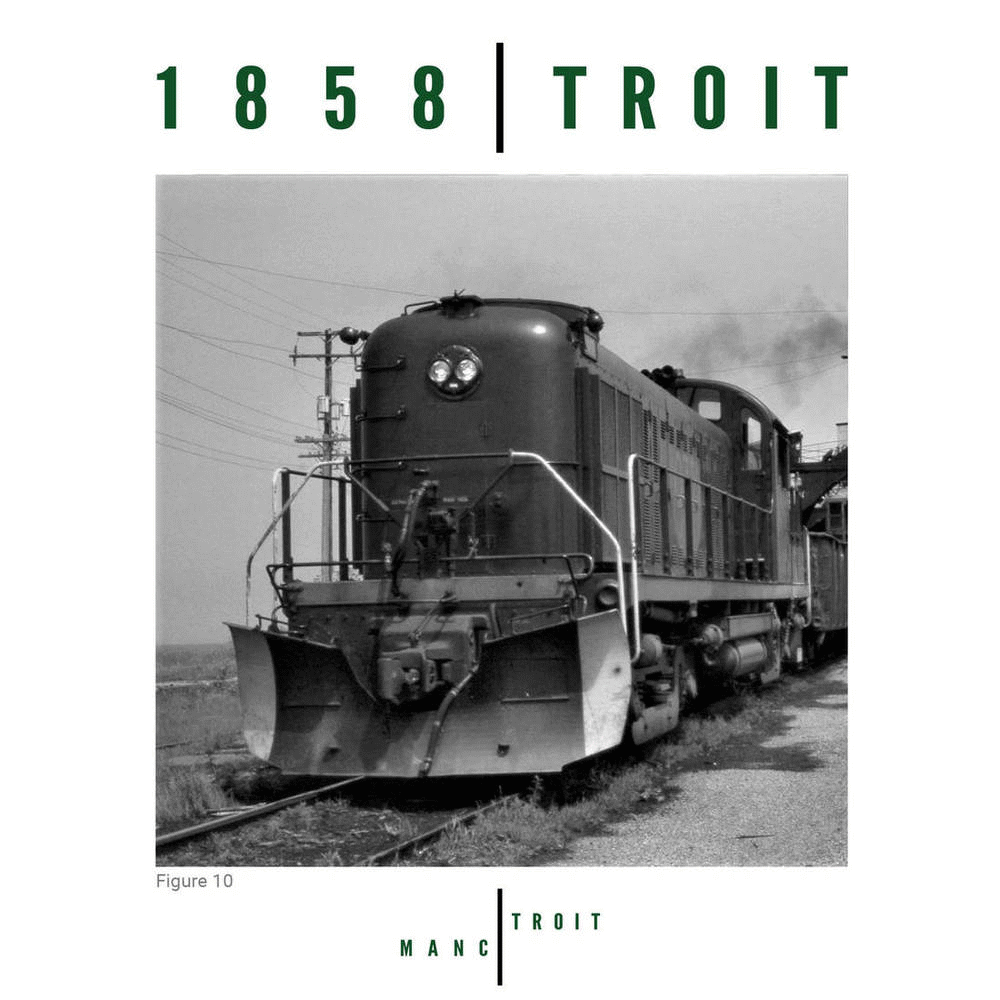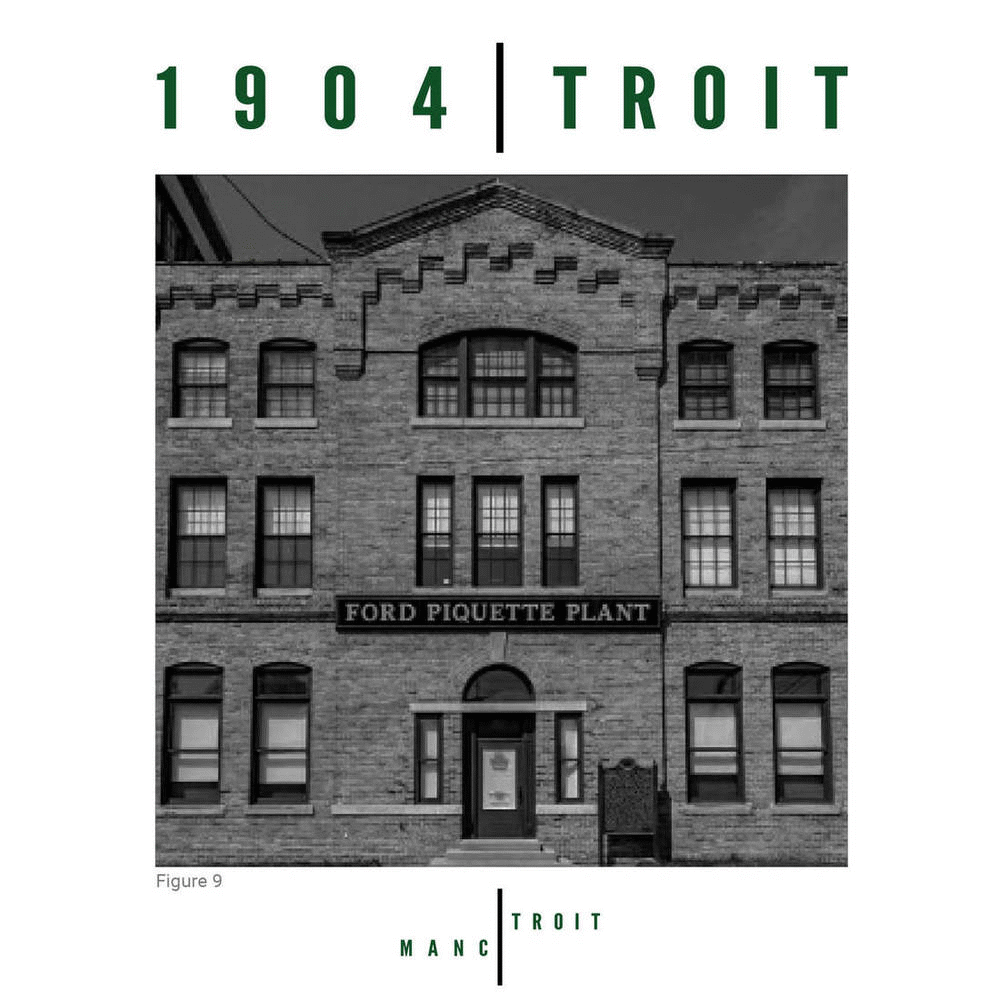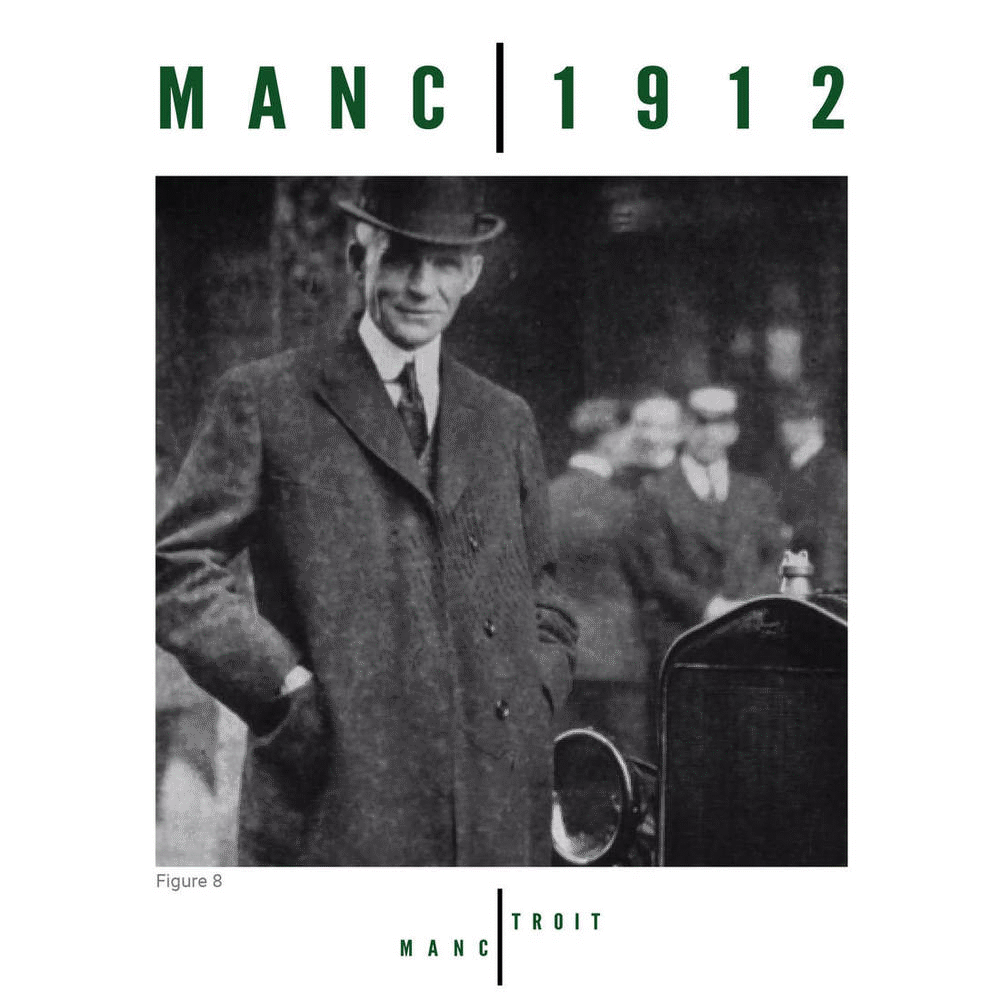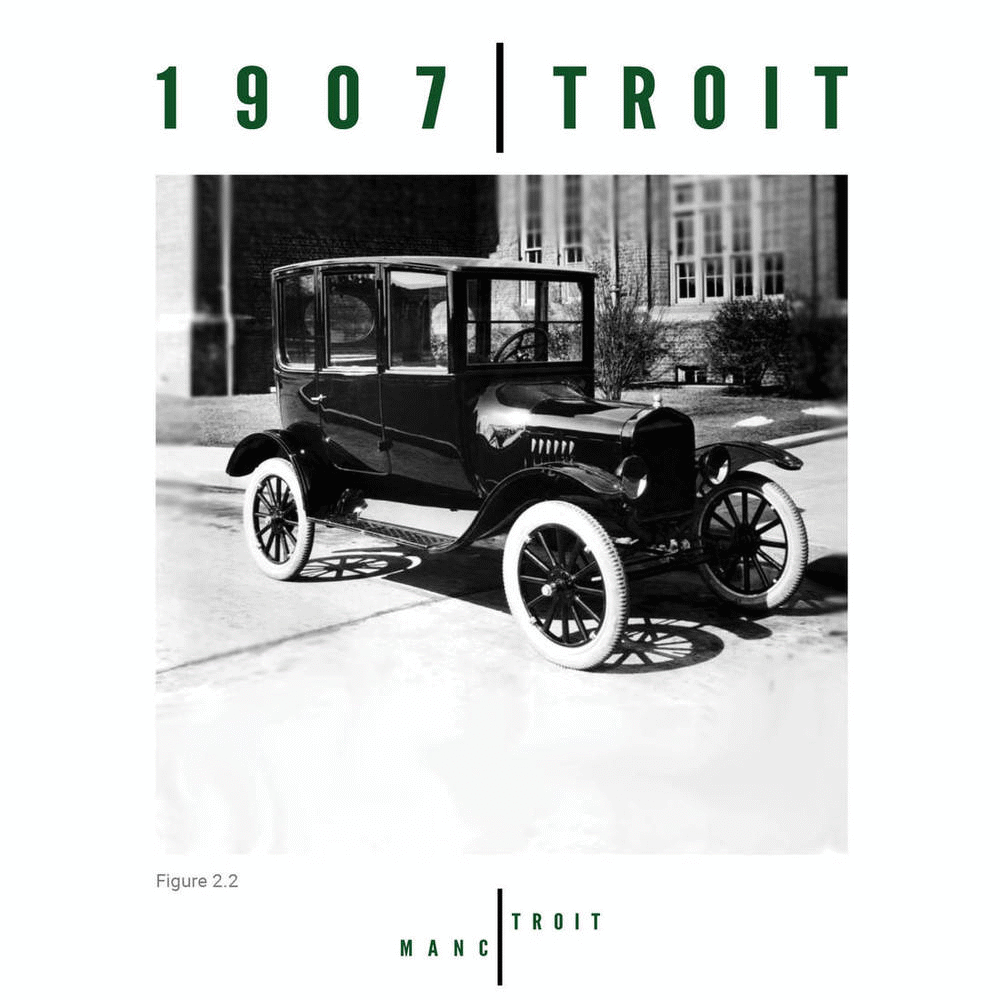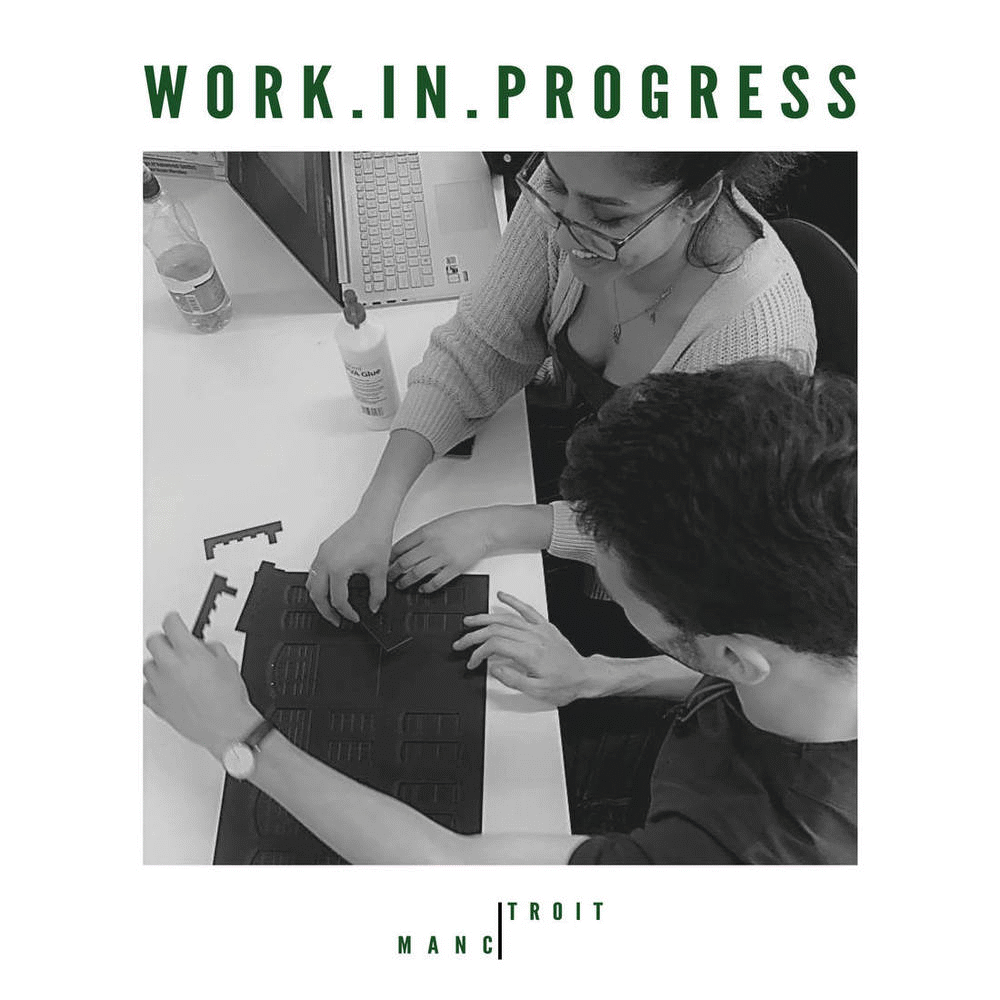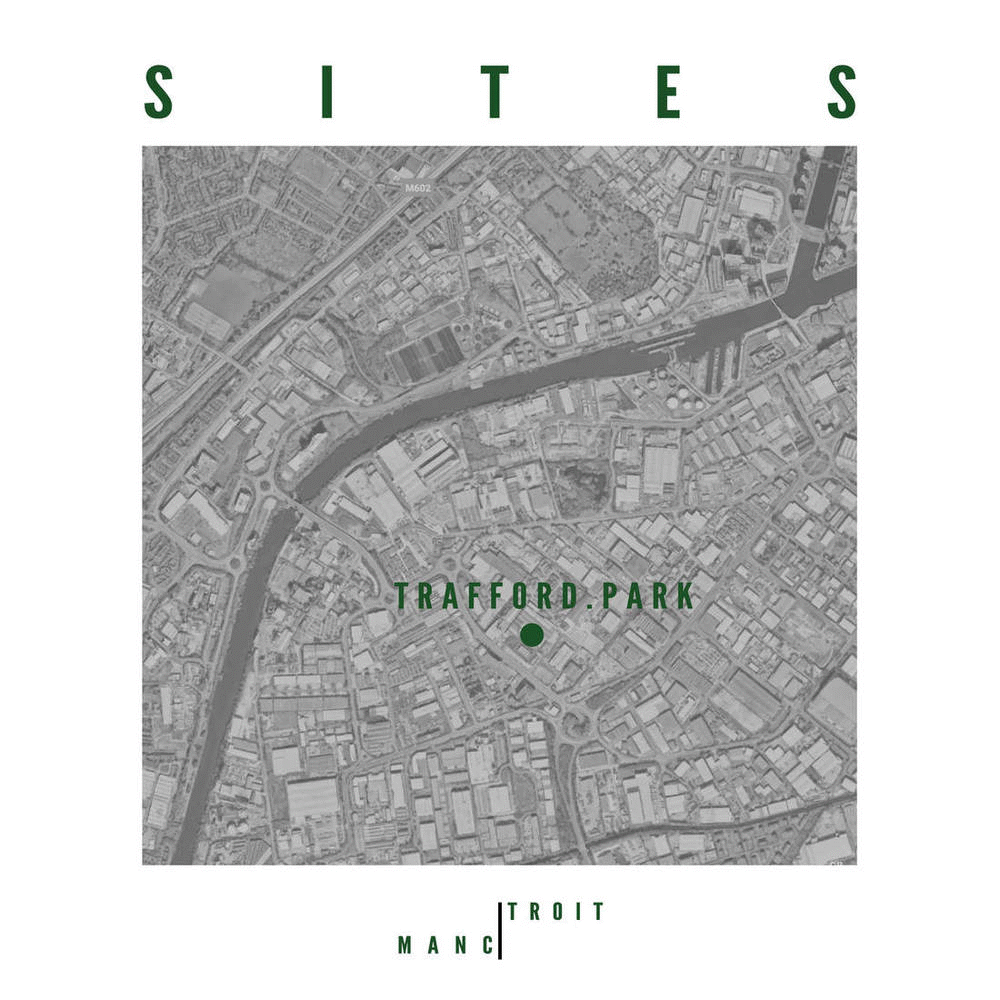FINAL OUTPUT
POSTCARD 10
The final postcard is bibliography of our research and list of figures documented by all the students.
Posted 5 Apr 2019 11:19
FINAL OUTPUT
POSTCARD 9
Detroit started to transport products by water in 1818 from the UK and USA. Products were transported by water or rail. In 1858 two railway lines were created in Detroit, which made the city an attractive location for manufacturers, as it had an easy access in order to export products to other parts of the country. It was after the American Civil War (1861-1865) when Detroit clearly became an industrial city. For these infrastructural connections, Detroit became the perfect spot for Henry Ford to open the factory. Very soon, Detroit became the world’s capital for the automobile production. (FordPiquettePlant, 2019)
Posted 5 Apr 2019 11:16
FINAL OUTPUT
POSTCARD 8
The Ford Piquette Plant was Henry Ford’s first car production factory, it oversaw the production of Ford models B, C, F, K, N, R, S, and T during its service. The building was a total of 3.11 acres, covering an entire city block and was located strategically next to the Michigan Central Railroad (Ford Piquette Avenue Plant, n.d.). It consisted of three storeys: the ground floor housed a machine shop, the shipping department and was used to test cars; the first floor was focused on assembly and storage; and the second, oversaw drafting, and final assembly of all vehicles. The Ford Motor Company’s presence in the plant ended in 1910 as it moved to the larger Highland Park Plant, selling the Piquette to automobile manufacturer, Studebaker in 1911. (Fordmotorhistory.com, n.d.)
Posted 5 Apr 2019 11:15
FINAL OUTPUT
POSTCARD 7
The Ford Motor company expanded its facilities to Trafford Park by purchasing a large low-cost site to grow the business. Henry Ford also saw the opportunities to stay in the fast line against competitors after being attracted to the great pool of skilled engineers in Manchester and the railway and canal connections to Detroit, creating an easy flow of shipments of components between the two factories. Manchester was the ideal place for the assemblage of The Model T cars, gaining a reputation in the British and European markets.
Posted 5 Apr 2019 11:14
FINAL OUTPUT
POSTCARD 6
During Ford’s trip to the UK he was impressed by the talented entrepreneur Percival Perry and his policy of fair wages. Perry was the company’s chairman who opened Ford’s first factory outside of North America in Great Britain. Ford was suprised by the British workers and their eagerness to work, surpassing their American counterparts in terms of productivity on the assembly line. On his return to America in 1914, Ford offered a daily $5 wage, doubling the rate of most of his workers. This proved to be a huge success. Instead of the constant turnover of employees, Ford created a stable workforce while streamlining the production process. The best mechanics in Detroit gathered at Ford, providing their expertise, raising productivity, and lowering training costs paving the way for modern mass production.
Posted 5 Apr 2019 11:13
FINAL OUTPUT
POSTCARD 5
The world’s first industrial estate, Trafford Industrial Park, first appeared on the map in the mid-1800s as 5 square miles of deer park and woodland (Herron, 2015). However, with the rapid industrial growth in Manchester, along with the completion of the Manchester Ship Canal in 1894; the land became high demand for potential industrial space and in 1986, London-based financier Ernst Terah Hooley purchased the land to do just that (Herron, 2015). Prior to Fotrd’s association to the park, the Westinghouse Electric Company was the first American company to open a factory in Trafford Park and in doing so, introduced an American style grid street layout that accommodated for workers families (Boardman, date unknown). This can still be seen in the park today.
Posted 5 Apr 2019 11:12
FINAL OUTPUT
POSTCARD 4
In the year 1911 the Ford assembly plant was the first factory to be built outside of the USA. (Friedman and Meredeen, 1980) The production of the Model T was established in Trafford Park, an industrialised region near Manchester since it had the canal connections for importation. The Ford Motor company employed over 50 people to work on the first mass produced car through repetitive labour and in the first year about 3000 cars (Ford of Britain: Yesterday today.., 1968, pp.52-54) were sold at $680, equivalent to £500. (conceptcarz.com, 2019) However, the price did not attract the attention of the working class as it was targeted towards the middle-class market.
Posted 5 Apr 2019 11:11
FINAL OUTPUT
POSTCARD 3
With the introduction of the Model T in 1907, Henry Ford envisioned “motor cars for the great multitude” (HISTORY, 2009). In order to create an affordable vehicle that could cater to the masses, the Model T would need to be built more efficiently and therefore need to be produced at a cheaper cost. Ford’s incorporation of an assembly line methodology was inspired by the continuous flow production that existed in food packing factories. By reducing the construction of the Model T to 84 simple steps and training workers to do one task, the assembly line was introduced. By 1914 production time per vehicle was cut down from 12 hours to a mere 93 minutes (Goss, 2018).
Posted 5 Apr 2019 11:10
FINAL OUTPUT
POSTCARD 2.2
The introduction of the Model T in 1907 was a huge success to the Ford Motor company. Due to the efficiency and reasonable pricing of the vehicle the Model T was in high demand therefore Ford had to alter how the industry works by having an assembly line mass overseas production in Manchester in order to manufacture the cars in great quantities (Detroithistorical.org, 2019). The local workforce in Manchester was vital for production plant, they were able to double the output from 3000 cars to 6000 after one year of its opening. (Thesahb.com, 2019)
Posted 5 Apr 2019 11:07
FINAL OUTPUT
POSTCARD 2.1
Model T. The design process of the model T was run by Ford’s hand-picked team (Ford Piquette Avenue Plant, n.d.). The first complete Model T for testing was produced in 1907. The model could seat five people and performed well. It was very well received by people as a lot of orders were made months before the car went into production.
Posted 5 Apr 2019 11:06
FINAL OUTPUT
POSTCARD 1
Henry Ford was born in Michigan in 1863. He was raised on a farm and from an early age he showed great interest in mechanical objects.
He married Clara Bryant in 1888 and a few years later the couple had their one child, a son, Edsel. He worked as an engineer for an illuminating company for a few years. Before founding the Ford Motor Company in 1903, Henry Ford had set up two other companies that had failed. The Ford Motor Company was very successful as after a few years of opening it was the leading automobile company. The company is mostly known for using the moving assembly-line and for designing and manufacturing the Model T.
Henry Ford died in 1947. (DetroitHistorical, 2019)
Posted 5 Apr 2019 11:04
DAY 4
The hard work continues. Our outputs begin to come together! Students working in the B.15 workshop in the morning started gluing the laser cut model of Ford Piquette. The work definitely required patience and precision. At the same time another 5 of us continued working on the mass model of Trafford Park. Both for the assembling and the laser cutting we are using the CAD file prepared before based on the photos and archival materials we gathered.
Posted 28 Mar 2019 17:07
DAY 4
Another productive morning! With 5 students working in the B.15 workshop, the rest of us concentrated on creating the timeline documenting the journey of Ford from Detroit to Manchester. For that we had to go back all the way to 1836 when the railway in Trafford Park was constructed as it was one of the reasons why Henry Ford came to Manchester. This is mirrored with constructing the railway in Detroit in 1858.
The most crucial year seems to be 1903 when not only the Ford Motor Company was opened in Detroit but also first 3 models of Ford car were sold in the UK! However, the Ford Factory in Trafford Park wasn`t opened till 1911 when it sold 3,000 cars in the first year of production.
Posted 28 Mar 2019 15:10
Recently we confirmed our route for the Trafford Park site visit. The day will start with the visit to the Science and Industry Museum. From there we will take two buses to Village Circle to then walk around the industrial neighborhood. We will concentrate on exploring Firs and Second Avenue and Westinghouse Roads which were the grounds on where the Ford factories used to stand. We hope for it to be a very insightful and informative day for all of us.
Posted 20 Mar 2019 20:33
TRAFFORD PARK is located in the southern side of Manchester, opposite Salford Quays. It was the first planned industrial estate in the world and still remains the biggest one in Europe. Our team will be visiting Trafford Park on the 2nd day of Events and then model it in the following days!
FORD PIQUETTE AVENUE PLANT in the northern centre of Detroit. It is the birthplace of the Ford Model T car and was the Ford Motor Company`s first purpose-built factory. Today it operates as a historic museum. We will be modelling the Piquette Plant as a part of our output!
Posted 14 Feb 2019 09:04

Our team will be developing a range of techniques, not only software and manual but also soft skills.
PHOTOSHOP
We will hold a Photoshop session where we will introduce our younger colleagues to this irreplaceable program. We will then use it to edit the photos of our models and to illustrate our research.
INDESIGN
Alongside Photoshop workshop we planned to give the students an insight into the tool that will be of utmost importance in their further studies. The knowledge gained during the session will be used to prepare postcards describing our models.
MODEL MAKING
Model making is one of the most important skills for architects, to be comfortable with it is crucial. It helps both to translate one`s ideas into a 3D form and also verify the decisions. Students, divided into two groups will be making models of the piquette plants in Detroit and Trafford Park in Manchester. We plan on using white cardboard in appreciation of the elegance and simplicity of the material.
PRESENTATION
Knowing how to present your work is a skill every architecture student should obtain. We will improve this technique by presenting our work twice to our collaborators during the Events 2019, first to the curator at the Science and Industry Museum, Katherine Belshaw and second time to MSA lecturer, Dominic Sagar.
RESEARCH
Every architecture student deals with research at one point of their studies and then later in their practice. We will introduce our students to various types of research. We plan on putting together archive documents documenting the journey of Henry Ford from Detroit to Manchester. The obtained materials will be crucial for the model making process. We will also research into the role of models in exhibitions.
Posted 9 Feb 2019 17:51
Meet our collaborator! Dominic Sagar is a full time lecturer at MSA and a founding partner in Sagar Stevenson Architects, a practice actively involved in setting up the ‘Northern Quarter Association’ which was a key figure in regeneration of that area.
Dominic is interested in the connections between Manchester and Detroit and so he will give us a lecture on the topic on the first day. We will be presenting our research to him on last Friday of the Events 2019.
Posted 7 Feb 2019 09:13
Today we met with our collaborator – the Curator of Industrial Heritage from the Museum of Science and Industry in Manchester who was interested in our ideas for the output and pleased with the approach we have taken. The Museum is curating an exhibition about industrial heritage of Manchester. During the Events 2019 our team will be visiting the museum as a part of exploring the role of models in exhibitions. We had an in depth discussion about our final outputs and have decided on two models of the piquette plants in Detroit and Trafford Park in Manchester to explore the journey of Henry Ford from America to Manchester.
Posted 5 Feb 2019 18:16

